![]()
![]()
![]()
M A R Z P A N A R M E N I A
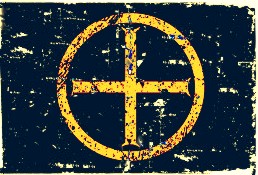
THE FLAG OF ARMENIA DURING THE MARZPANATE.
GOLDEN EQUAL ARMED ENCIRCLED CROSS UPON THE BLUE FIELD.
THE TIPS OF THE [SOLAR] CROSS WERE CRESCENT [LUNAR] SHAPED.
BETWEEN THE VTH AND IXTH CENTURIES
GREATER ARMENIA WAS RULED BY THE ARMENIAN ARISTOCRACY
WITHIN THE SOCIAL ORDER OF THE NAKHARAR [FEUDAL NOBILITY]
SYSTEM
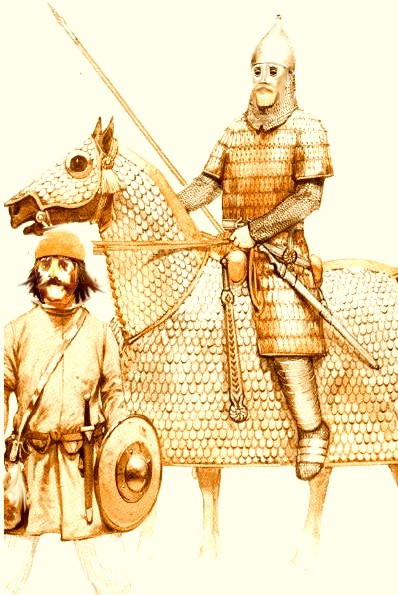
ARMENIAN CATAPHRACT OF THE FIFTH CENTURY AD. THE ARMENIAN
CAVALIERS
OF THE AYRUDZI WERE THE PRIDE OF THE NATION. RENOWNED THROUGHOUT
THE ANCIENT WORLD. EVEN BEFORE THE BREAK UP OF THE ROMAN EMPIRE
INTO TWO HALVES ARMENIAN NOBILITY AND THE ARMENIAN WARRIOR CLASS
BECAME AN IMPORTANT AND INTEGRAL PART OF THE ROMAN EMPIRE, INTRO-
DUCING MITHRAIC MYSTERIES INTO THE ARMY THAT QUICKLY
BECAME AN INDUCTION RITE FOR VIRTUALLY EVERY ROMAN EMPIRE
FROM FIRST CENTURY ONWARD. THE KNIGHTS AND CHIVALRIC ORDERS
IN MEDIEVAL EUROPE WERE SIMPLY A CONTINUATION OF THE OUTSTANDING
TRADITION OF ARMENIAN MITHRAIC WARRIOR NOBILITY.
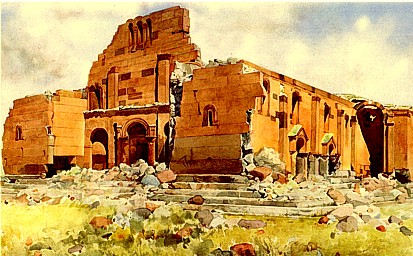
R U I N S O F T H E E
R E R U Y K B A S I L I C A
[F I F T H C E N T U R Y]
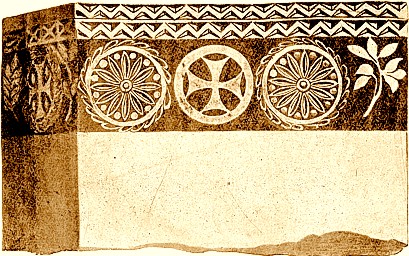
A SECTION OF THE CAPITOL OF THE ERERUYK BASILICA

SEVENTH CENTURY ATTIRE OF AN ARMENIAN NAXARAR.
T H E T A N U T E R P R I N C E S
Vasak Siwni (443-451)
Atrvšnasp (464-482)
Sahak Bagratid (482)
Vahan Mamikonean (485)
Theodore Rštuni (639-654)
Hamazasp Mamikonean (654-661)
Grigor Mamikonean (661-685)
Ašot Bagratid (685-689)
Nerseh Kamsarakan (689-693)
Smbat Bagratid (693-726)
Ašot Bagratid (732-749)
Mushegh Mamikonean (749-753)
Sahak Bagratid (753-770)
Smbat Bagratid (770-775)
Ašot Bagratid (775-781)
Tačat Anjevac‛i (781-785)
Ašot the Carnivorous Bagratid (790-826)
Bagarat Bagratid -- Prince of Princes (826-850)
Smbat the Confessor Bagratid (852-855)
Ašot Bagratid (855-859)

BEGINNING IN THE VITH CENTURY LEADING ARMENIAN ARISTOCRATIC
MILITARY
COMMANDERS BECAME BYZANTINE EMPERORS AND EMPRESSES. NO LESS
THAN 20 ARMENIANS BECAME EMPERORS OF THE BYZANTINE [EASTERN ROMAN]
EMPIRE AND IN THE IXTH CENTURY ESTABLISHED THE SUCCESSIVE ARMENIAN -
MACEDONIAN DYNASTY.
THE ARMENIAN STATE FORMING AND CIVILIZING DRIVE ONCE AGAIN
AS THROUGHOUT COUNTLESS MILLENNIA THROUGHOUT THE WORLD
FOUND ITS MANIFESTATION IN BYZANTIUM.

1. Maurice of Awšakan (582-602)
2. Vardan Pikick (711-713)
3. Artavasdes - (742-743)
4. Leo V Artsruni (813-830)
5. Basil Arsacid [founder of the Armenian -
Macedonian Dynasty] (867-886)
6. Leo VI the Philosopoher [Arsacid] (886-912)
7. Alexander (912-913)
8. Constantine VII Bagratid (913-959)
9. Roman I Vashtakian (919-949)
Co-rule with Constantine VII Bagratid
10. Roman II (959-963)
11. Nicephor II Phoka the Great (963-969)
12. John Tzimcus ( 969-976)
13. Basil II (976-1025)
14. Constantine VIII (1025-1028)
15. Roman III (1028-1034)
16. Michael IV Paphlagonian (1034 1041)
17. Michael V Kalapat (1041-1042.
18. Constantine IX Monomachus (1042-1054)
19. Theodora II (1054-1056)
20. Michael II (1056-1057)
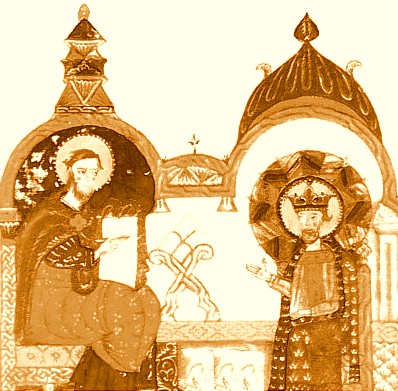
MEDIEVAL MANUSCRIPT DEPICTING THE FIFTH CENTURY FATHER OF
ARMENIAN HISTORY MOWSĒS XORENAC‛I AND HIS PATRON
SAHAK BAGRATID WHO
RULED IN SECOND HALF OF FIFTH CENTURY AD AND COMMISSIONED THE GREAT
HISTORIAN TO WRITE THE HISTORY OF ARMENIA FROM THE ANCIENT TIMES
TO THEIR OWN ERA.
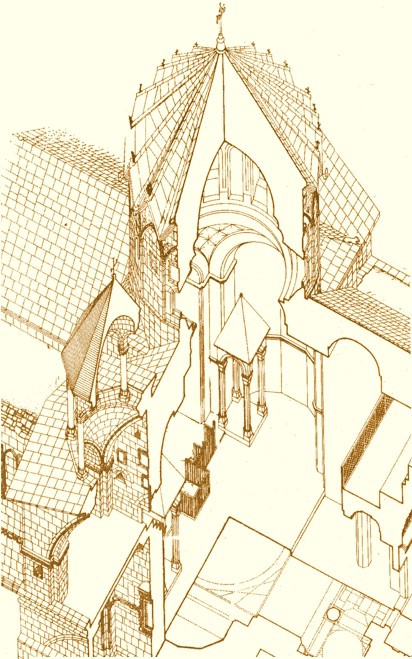
THE SACRED HARMONIC LAYOUT OF ARMENIAN CHURCHES BASED ON
PRIMORDIAL
MITHRĆA AND THE PYRAMIDAL MANNER AS FOUND IN
MUSASIR TEMPLE.
PROFOUND SYNTHESIS ENCOMPASSING LAYERS ON TOP OF LAYERS.
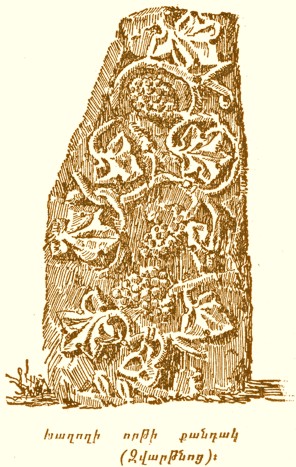
A PORTION OF SACRED GRAPE [FERTILITY] RELIEFS ON
FRAGMENTS OF ZVARTNOC‛ CATHEDRAL.

MASTER BUILDERS OF ZVARTNOC‛
WITH THE TOOLS OF THE CRAFT.
REMNANTS OF THE RELIEFS ON THE PILLARS OF THE CATHEDRAL.
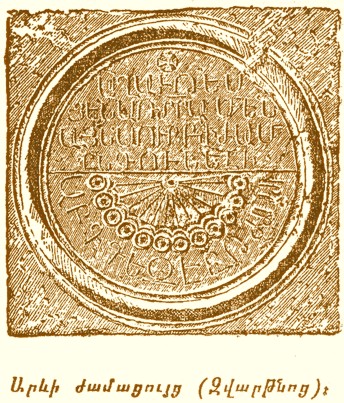
THE SUNDIAL OF THE ZVARTNOC‛
CATHEDRAL. THE VERY SYMBOL OF THE SUN
[DOT WITHIN THE CIRCLE] WITH THE OFF-SHOOT 12 HOURS/RAYS MARKED WITH
ARMENIAN LETTERS [EACH ALSO CONNOTING THE NUMERIC VALUE].
THE EQUAL ARMED ENCIRCLED CROSS PATTÉE AT THE TOP.
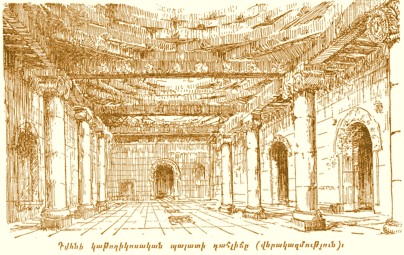
RECONSTRUCTION OF ONE OF THE HALLS OF THE CATHOLICOSAL PALACE
AT DVIN [DUIN]. VITH CENTURY.
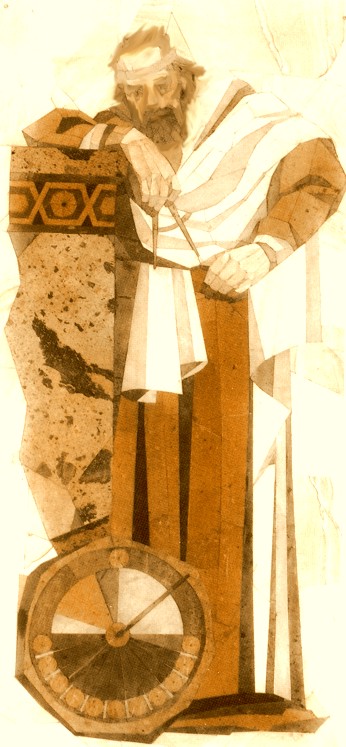
ANANIA OF ŠIRAK
[610-685]. THE OUTSTANDING SEVENTH CENTURY
ARMENIAN MATHEMATICIAN, GEOGRAPHER, CARTOGRAPHER
AND ASTRONOMER.

SIXTH CENTURY SARCOPHAGUS OF AN ARMENIAN NOBLEMAN IN
RAVENNA, ITALY. ARMENIAN ARISTOCRACY INTRODUCED MITHRAISM
TO ALL PARTS OF THE ROMAN EMPIRE. THE CROSS CONNOTES THE
LATER CHRISTIANIZATION BUT, THE DISTINCT ARMENIAN MITHRAIC
DRESS [CAP AND ROBES], THE TWIN LIONS, AND THE TWIN PILLARS
SUPPORTING THE ARCH [SUN ON THE HORIZON] AND THE EXTENDED HANDS
CLEARLY SHOW THE CONTINUATION OF THE SACRED ARMIN TRADITION.
COUNTLESS BYZANTINE MILITARY COMMANDERS [STRATEGOI] WERE ARMENIAN
GENERALS FROM RENOWNED ARMENIAN ARISTOCRATIC HOUSES.
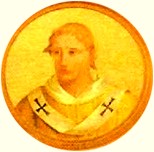
ICON OF LEO V IN BYZANTINE CHURCH
Sittas (528)
Buz (538)
Balisarios (545)
Nerses (555)
Vardan Mamikonian (571)
Smbat Bagratid (582)
Atat Khorkhrouny (601)
Vardan Pilick (711)
Vasack Patrik (741)
Musheg Alex (792)
Arshavir Patrick (807)
Manuel Mamikonian (830)
[known as the Byzantine Achilles]
Hobgan Kurkuas (941)
[conquered 1000 cities and was called the Greatest]
Mlag (Melios) the Great (934)
[noted in the Byzantine epic Diogonis - Akritas]
Vard Skleros (976)
Vard Pokas (987)
Magistros Bagratid (990)
Gregory of Taron (996)
Nikephor Tsrviz (1022)
Levon Tornik Bagratid (1047)
At least 80 Armenian generals along with their
unmatched cavalry held highest ranks in the military
of the Byzantine Empire throughout the reign
of Armenian and Greek Emperors on the Byzantine throne.
Through Byzantium Armenian aristocracy also played a quintessential role
in laying the foundation of newly emerging states like Kievan Rus
and Bulgaria, where many Armenian generals, queens, patriarchs,
scientists and craftsmen would have a enduring civilizing influence.
From 837 until 843 the Patriarch of Constantinople was the
renowned Armenian scientist John of Karahan.
The creators of the ancient Slavic alphabet Cyrill and Mephodius were the sons
of Levon and the pupils of John of Karahan in the University of Magnavr.
They
created the alphabet which consisted of 36 letters just like in Armenian
(not based on Greek one made up of 24 letters) created by Mesrob Mashtots.
Anna, the sister of Armenian Byzantine Emperor Basil II, in 988, married
Kievan Prince Vladimir Svyatoslav, on condition that he and all
of Kievan Russia adopts Christianity. Vladimir accepts the offer and Russia
was thereafter baptized by Armenian priests. The patriarchs of the Orthodox
Byzantine Church, throughout the years, were Armenian including:
Melitos (360)
Apgtikos (406-427)
Isaak (625-643)
John of Karahan (837-843)
Stephan (888)
Teophilintos (931-1057)
Bagrat Pankratios (IXth century)
Kiev was founded by no other than the Armenian prince Smbat Bagratid in
585, and was originally named Smbatos. The mother of Vladimir Monomachus
(1053-1125) Mariam (Maria) was the daughter of the Armenian Byzantine
Emperor Constantine IX Monomachus (1042- 1054). It is from Constantine IX
that Vladimir inherited the nickname Monomachus.
Mariam married Varangian Prince Vsevolod, the son of Yaroslav the Wise,
the Great Prince of Kievan Russia, the son of Vladimir Monomachus, the
Great prince Yuri Dolgoruky (1096- 1157) the founder of Moscow (1147),
is mentioned in the Russian chronicles as "Grugy" or "Kriuk", that is to
say George. The Cathedral of St. George was erected in Vladimir, in his honor
between 1158-1164. The grandchild of Yury Dolgoruky and the husband of the
Queen of Georgia Tamar (Georgian branch of Bagratids), was named George.
The Bagratid royal lion was adopted as the coat of arms of the Armenian
princely house of Dolgoruky-Argutinsky, an offshoot of Bagratids in Russia.
This lion was also the escutcheon of Yury Dolgoruky.
The VIth century Armenian historian Zenon Glak in his The
History of Taron, writes about Kuar (Kiev), Sheke (Meltey) and Chorean :
"Kuar built the city naming it after him. And Meltey
built a city in the same valley and named it Meltey (Shekovitsa). And
Khorean built a city in the district of Paluni and named it after him Khorean
(Korevan). The city Smbatas was founded on the mountain of Zamk (Kiselevka).
Kiev appeared on the mountain of Andreev, which was founded
by Kie (where the Historical Museum of Kiev is now standing). Thus near the
City of Smbatas situated on the Zamk mountain appeared three cities:
Kiev, Shekovitsa and Korevitsa. The Byzantine historians in 948 wrote:
"The Rus are going downstream the River Dnepr and are gathering in
the Kiev fortress, called Smbatas."
There were other cities with Armenian names: Armen (Romen), Artan, Artavet.
They were in the suburbs of Kiev. In the Arabic sources of 9-11 centuries
mention the city of Artavet and the renowned Armenian weapon
makers there who were particularly renowned for producing some of the best
swords of the era. Yury Dolgoruky, for the first time in history, Christened the
name 'Moscow' in March of 1142. An inscription in Armenian made by Yury
Dolguruky survives and has reached us where he sends an invitation to
one of his Armenian relatives "Come to my place, in Moscow, my brother."
V.N. Tatishev describes Yury Dolgoruky, according to Kievan primary sources,
in this way: "This great Prince was tall and stout with white face and
small eyes, with long and curve nose, with short beard. He was the great
lover of women, sweets and drinks. In a word, the powerfull founder and
ruler of Moscow, Suzdal, Vladimir, Yaroslav, Rostov - Dmitrov and the
other cities, was full of courage."
In Vladimir, the Capital City of Yury Dolgoruky, after his death
in 1157, the Cathedral of St. George was erected in his honor between 1158 -
1164
and the famous Golden Gates of Vladimir led to the Capital.

![]()
![]()